Have you ever dreamed of seeing a monkey with a long nose, a pig with a beard, or a lizard with a forked tongue? If you have, then you should visit Bako National Park, the oldest and one of the most popular national parks in Sarawak, Malaysia.
Bako National Park is located at the tip of the Muara Tebas peninsula, about 37 km from Kuching, the capital city of Sarawak. The park covers an area of 27.27 square kilometers, and is home to a rich variety of flora and fauna. It is also known for its stunning coastline, with sandy beaches, rocky cliffs, and sea stacks.
Visiting Bako National Park is a great way to experience the beauty and diversity of Sarawak’s nature and culture. You can see the endemic proboscis monkeys, the rare silvered langurs, the friendly bearded pigs, and the impressive monitor lizards. You can also explore the different types of vegetation, from mangrove to kerangas to swamp to cliff. You can also enjoy the scenic views of the sea, the rocks, and the waterfalls. And you can also learn about the local people, who live in fishing villages, longhouses, and temples.
If you are looking for a place to see wildlife and nature in Sarawak, Malaysia, you can’t miss Bako National Park. In this article, we will show you how to plan a perfect Bako National Park day trip, and what to do, see, bring, and avoid in this amazing park. We will also tell you how to book a tour with my.trip.com, the best travel website for your Malaysian adventure.
💖Tip: When planning your trip, for a comfortable stay, search for hotels in Kuching in advance to get the best rates.
How to get to Bako National Park

There are two ways to get to Bako National Park from Kuching: by car or by public bus. Both options require a boat ride from the Bako village to the park headquarters, which is the only entrance to the park.
By car
If you have your own car or rent one, you can drive to Bako village, which is about 37 km from Kuching. The drive takes about an hour, depending on the traffic and the road conditions. You can park your car at the Bako village jetty, where you can buy your boat ticket and your park entrance fee. The boat ride takes about 20 minutes, and costs RM40 per person for a return trip. The park entrance fee is RM20 per person for foreigners, and RM10 per person for Malaysians.
By public bus
If you prefer to take public transportation, you can catch the bus number K6 from Kuching to Bako village. The bus departs from the Kuching Waterfront, near the Open Air Market, every hour from 7 am to 5 pm. The bus fare is RM4 per person for a one-way trip. The bus ride takes about an hour and a half, depending on the traffic and the stops. You can buy your boat ticket and your park entrance fee at the Bako village jetty, as mentioned above.
Tips
- To save money and time, you can share a car or a boat with other travelers, especially if you are traveling solo or in a small group. You can find other travelers at the Kuching Waterfront, the Bako village jetty, or the park headquarters.
- To avoid the crowds and the heat, you can go early or late in the day, when the park is less busy and the weather is cooler. The first boat leaves at 8 am, and the last boat leaves at 3 pm. The park opens at 8 am, and closes at 5 pm.
- To ensure your safety and convenience, you can book your boat ticket and your park entrance fee in advance with my.trip.com, which offers a hassle-free and secure online booking service. You can also book a guided tour with trip.com, which includes transportation, boat ride, park entrance fee, and a professional guide.
- Sehala
- Pergi Balik
- direct cheapest
 KUL10:501j 50mTanpa hentiKCH12:40Kuala Lumpur - Kuching|Rab, 14 Jan|AirAsiaSEK 182SEK 21114% OFF14% OFFSEK 211SEK 182
KUL10:501j 50mTanpa hentiKCH12:40Kuala Lumpur - Kuching|Rab, 14 Jan|AirAsiaSEK 182SEK 21114% OFF14% OFFSEK 211SEK 182  KUL19:551j 50mTanpa hentiKCH21:45Kuala Lumpur - Kuching|Isn, 12 Jan|AirAsiaSEK 188SEK 21111% OFF11% OFFSEK 211SEK 188
KUL19:551j 50mTanpa hentiKCH21:45Kuala Lumpur - Kuching|Isn, 12 Jan|AirAsiaSEK 188SEK 21111% OFF11% OFFSEK 211SEK 188 KUL10:501j 50mTanpa hentiKCH12:40Kuala Lumpur - Kuching|Isn, 19 Jan|AirAsiaSEK 188SEK 21111% OFF11% OFFSEK 211SEK 188
KUL10:501j 50mTanpa hentiKCH12:40Kuala Lumpur - Kuching|Isn, 19 Jan|AirAsiaSEK 188SEK 21111% OFF11% OFFSEK 211SEK 188 KUL1:00 PM3j 5mTanpa hentiKCH2:00 PMKuala Lumpur - Kuching|Sat, Dec 13|AirAsiaCari Penerbangan LainCari Penerbangan Lain
KUL1:00 PM3j 5mTanpa hentiKCH2:00 PMKuala Lumpur - Kuching|Sat, Dec 13|AirAsiaCari Penerbangan LainCari Penerbangan Lain
Harga potongan adalah dikira berdasarkan harga purata laluan sepadan pada Trip.com.
What to do in Bako National Park

There are many things to do in Bako National Park, depending on your interests and preferences. The main activities are hiking, wildlife watching, beach hopping, and photography.
Hiking
Hiking is one of the best ways to explore the park, as there are 16 marked trails that range from easy to challenging, and from 0.5 km to 12.8 km in length. The trails cover different types of terrain and vegetation, and offer different views and attractions. Some of the best trails are:
- Telok Pandan Besar trail: This is a moderate trail that is 2.6 km long, and takes about 2 hours to complete. It leads to a secluded beach with a spectacular sea stack, which is one of the most iconic landmarks of the park. The trail also passes through a kerangas forest, which is a type of heath forest that is unique to Borneo.
- Telok Paku trail: This is an easy trail that is 0.8 km long, and takes about 30 minutes to complete. It leads to a small beach with a view of the Muara Tebas peninsula, where you can see the Malay fishing village and the Chinese temple. The trail also offers a good chance to see the proboscis monkeys, which are usually active in the morning and evening.
- Tanjung Sapi trail: This is a challenging trail that is 1.75 km long, and takes about 2 hours to complete. It leads to a rocky cliff with a panoramic view of the South China Sea, where you can see the Serait rock, another sea stack that resembles a cobra. The trail also passes through a mangrove forest, which is a type of wetland that is home to many aquatic animals.
Wildlife watching
Wildlife watching is another popular activity in the park, as there are over 150 species of birds, 25 species of mammals, 37 species of reptiles, and 17 species of amphibians that live in the park. Some of the best wildlife to see are:
- Proboscis monkeys: These are the star attraction of the park, as they are endemic to Borneo, and can only be found in a few places. They are known for their distinctive long noses, which are used to attract mates and to communicate. They are also known for their loud calls, which can be heard from a distance. They usually live in groups of 10 to 30 individuals, and feed on leaves, fruits, and seeds. They are most active in the morning and evening, and can be seen along the coast or near the water sources.
- Silvered langurs: These are another rare species of monkeys that can be found in the park. They are also endemic to Borneo, and have a silvery-gray fur that blends with the environment. They are also known as leaf monkeys, as they mainly feed on leaves, especially young ones. They usually live in groups of 5 to 15 individuals, and are very agile and acrobatic. They are most active in the morning and afternoon, and can be seen in the forest canopy or on the ground.
- Bearded pigs: These are the largest and most common mammals in the park, and can be seen almost everywhere. They are named for their long whiskers, which are used to sense their surroundings. They are also known as omnivorous pigs, as they feed on almost anything, from roots to fruits to insects to carrion. They usually live in groups of 2 to 10 individuals, and are very friendly and curious. They are most active in the morning and evening, and can be seen near the park headquarters or the beaches.
- Monitor lizards: These are the largest and most impressive reptiles in the park, and can be seen in various habitats. They are named for their long tails, which are used for balance and defense. They are also known as carnivorous lizards, as they feed on eggs, fish, birds, rodents, and even smaller lizards. They usually live alone, and are very territorial and aggressive. They are most active in the morning and afternoon, and can be seen near the water sources or the trails.
Beach hopping
Beach hopping is another fun activity in the park, as there are several beaches that offer different features and attractions. The beaches are not suitable for swimming, as there are strong currents, sharp rocks, and stinging jellyfish. However, they are great for relaxing, sunbathing, picnicking, and enjoying the scenery. Some of the best beaches are:
- Telok Pandan Besar beach: This is the most famous and most visited beach in the park, as it has the Sea Stack, which is a huge rock that stands out from the sea. The beach is also surrounded by cliffs and forest, which create a dramatic contrast. The beach is accessible by the Telok Pandan Besar trail, or by boat from the park headquarters.
- Telok Assam beach: This is the closest and most convenient beach in the park, as it is located near the park headquarters. The beach has a view of the Bako village and the Muara Tebas peninsula, which create a cultural and historical atmosphere. The beach is also a good spot to see the sunset, as the sky turns into different colors. The beach is accessible by a short walk from the park headquarters, or by boat from the Bako village.
- Telok Delima beach: This is the most secluded and most pristine beach in the park, as it is rarely visited by tourists. The beach is also a good spot to see the proboscis monkeys, as they often come to the beach to feed on the fruits and leaves. The beach is accessible by the Telok Delima trail, or by boat from the park headquarters.
Photography
Photography is another rewarding activity in the park, as there are many opportunities to capture the beauty and diversity of the park. The park offers a variety of subjects, such as the wildlife, the vegetation, the coastline, and the rock formations. Some of the best spots to take photos are:
- Sea Stack: This is the most iconic and most photographed landmark of the park, as it is a huge rock that stands out from the sea. The Sea Stack can be seen from the Telok Pandan Besar beach, or from the boat ride to the park headquarters. The best time to take photos of the Sea Stack is in the morning, when the sun is behind it, or in the evening, when the sun is in front of it.
- Serait rock: This is another impressive and unique landmark of the park, as it is a rock that resembles a cobra. The Serait rock can be seen from the Tanjung Sapi trail, or from the boat ride to the park headquarters. The best time to take photos of the Serait rock is in the afternoon, when the sun is above it, or in the evening, when the sun is behind it.
- Mangrove forest: This is a fascinating and diverse habitat of the park, as it is a type of wetland that is home to many aquatic animals. The mangrove forest can be seen from the Tanjung Sapi trail, or from the boat ride to the park headquarters. The best time to take photos of the mangrove forest is in the morning, when the light is soft, or in the evening, when the light is warm.
Tips
- To make the most of your time in the park, you can check the tide times, as some of the beaches and trails are only accessible during low tide. You can also follow the park rules, such as not feeding or disturbing the wildlife, not littering or damaging the plants, and not making loud noises or playing music. You can also hire a guide, who can show you the best spots and tell you more about the park.
- To book a tour with my.trip.com, you can visit their website, where you can find various options and packages for your Bako National Park day trip. You can also read the reviews and ratings from other travelers, who have enjoyed their experience with my.trip.com. You can also contact their customer service, who can answer your questions and help you with your booking.
What to see in Bako National Park

There are many things to see in Bako National Park, besides the wildlife and the beaches. The park also has a rich and diverse vegetation, which reflects the different types of terrain and climate. The park also has some amazing rock formations, which are shaped by the erosion and weathering of the sandstone. The park also has some cultural and historical sites, which showcase the local people and their traditions. Some of the best things to see are:
Vegetation
The park has seven types of vegetation, which are mangrove, kerangas, swamp, cliff, grassland, mixed dipterocarp, and peat swamp. Each type of vegetation has its own characteristics and adaptations, and supports different kinds of plants and animals. Some of the best examples of the vegetation are:
- Mangrove: This is a type of wetland that grows along the coast, where the salt water and fresh water meet. The mangrove plants have special roots that help them to breathe and anchor in the muddy soil. The mangrove plants also provide shelter and food for many aquatic animals, such as crabs, fish, and mudskippers.
- Kerangas: This is a type of heath forest that grows on poor and acidic soil, where the nutrients are scarce. The kerangas plants have small and thick leaves that help them to conserve water and prevent evaporation. The kerangas plants also have colorful and fragrant flowers that attract pollinators, such as bees, butterflies, and birds.
- Swamp: This is a type of wetland that grows in low-lying areas, where the water is stagnant and shallow. The swamp plants have large and broad leaves that help them to float and photosynthesize. The swamp plants also have aerial roots and stems that help them to absorb oxygen and nutrients from the air and water.
Rock formations
The park has some spectacular and unique rock formations, which are formed by the erosion and weathering of the sandstone. The rock formations have different shapes and sizes, and create a dramatic landscape. Some of the best examples of the rock formations are:
- Sea Stack: This is a huge rock that stands out from the sea, and is one of the most iconic landmarks of the park. The Sea Stack is formed by the erosion of the waves and the wind, which carve out the base of the rock, leaving a narrow and tall pillar. The Sea Stack is also covered by vegetation, which adds to its beauty and contrast.
- Serait rock: This is a rock that resembles a cobra, and is another unique landmark of the park. The Serait rock is formed by the weathering of the sandstone, which creates cracks and fissures on the surface of the rock, giving it a snake-like appearance. The Serait rock is also surrounded by water, which creates a reflection and a mirage effect.
- Tajor waterfall: This is a waterfall that flows from a cliff, and is one of the most scenic attractions of the park. The Tajor waterfall is formed by the runoff of the rainwater, which collects on the top of the cliff, and then falls down to the pool below. The Tajor waterfall is also a good place to cool off and relax, as the water is fresh and clean.
Cultural sites
The park has some cultural and historical sites, which reflect the local people and their traditions. The park is inhabited by three main ethnic groups, which are the Malay, the Bidayuh, and the Chinese. Each group has its own culture and history, and contributes to the diversity and richness of the park. Some of the best examples of the cultural sites are:
- Malay fishing village: This is a village that is located near the Bako village jetty, and is the oldest and largest settlement in the park. The Malay fishing village is composed of wooden houses that are built on stilts, and are connected by wooden bridges. The Malay fishing village is also a source of income and livelihood for the locals, who fish and sell their catch to the tourists and the park staff.
- Bidayuh longhouse: This is a house that is located near the park headquarters, and is the only remaining longhouse in the park. The Bidayuh longhouse is composed of a single structure that is divided into several rooms, and is shared by several families. The Bidayuh longhouse is also a source of culture and heritage for the locals, who preserve and practice their customs and rituals, such as the Gawai festival and the bamboo dance.
- Chinese temple: This is a temple that is located on the Muara Tebas peninsula, and is the only religious site in the park. The Chinese temple is composed of a colorful and ornate building that is dedicated to the sea goddess, Mazu. The Chinese temple is also a source of faith and devotion for the locals, who pray and offer sacrifices to the sea goddess, especially during the Chinese New Year and the Hungry Ghost festival.
Tips
- To appreciate the beauty and diversity of the park, you can learn more about the plants and animals that live in the park, and how they adapt and survive in their habitats. You can also respect the local culture and history, and observe their way of life and their traditions. You can also be environmentally friendly, and avoid harming or disturbing the natural and cultural resources of the park.
What to bring to Bako National Park

Packing light and smart is important for your Bako National Park day trip, as there are no lockers or storage facilities in the park. You will have to carry everything you need for the day, and keep your valuables close to you. Here are some of the essential, optional, and avoidable items to bring to the park:
Essential items
These are the items that you must bring to the park, as they are necessary for your safety and comfort. They are:
- Water: You will need at least 2 liters of water per person, as the park is hot and humid, and you will sweat a lot. You can refill your water bottle at the park headquarters, or buy bottled water at the canteen. You can also bring a water filter or purification tablets, as the tap water is not safe to drink.
- Snacks: You will need some snacks to keep your energy and mood up, as the park is large and tiring, and you will burn a lot of calories. You can bring some nuts, dried fruits, granola bars, or chocolate, as they are easy to carry and eat. You can also buy some snacks at the canteen, or bring your own lunch, as there are no restaurants in the park.
- Sunscreen: You will need some sunscreen to protect your skin from the sun, as the park is exposed and sunny, and you will be outdoors for a long time. You can bring some SPF 30 or higher, and reapply it every 2 hours, or after swimming or sweating. You can also bring some lip balm, as your lips can get dry and cracked.
- Insect repellent: You will need some insect repellent to protect yourself from the insects, as the park is full of mosquitoes, flies, ants, and leeches. You can bring some DEET-based or natural repellent, and apply it on your skin and clothes, and avoid scratching or rubbing the bites. You can also bring some antihistamine cream, as some insects can cause allergic reactions.
- Hat: You will need a hat to cover your head from the sun, as the park is hot and bright, and you will be exposed for a long time. You can bring a wide-brimmed hat, a baseball cap, or a bandana, as they are easy to wear and carry. You can also bring a scarf, as it can protect your neck and face from the sun and the insects.
- Sunglasses: You will need some sunglasses to protect your eyes from the sun, as the park is bright and glarey, and you will be looking at the sea and the rocks. You can bring some polarized sunglasses, as they can reduce the glare and enhance the contrast. You can also bring some eyeglasses, as they can protect your eyes from the dust and the branches.
- Camera: You will need a camera to capture the beauty and diversity of the park, as the park is full of amazing sights and scenes. You can bring a digital camera, a smartphone, or a GoPro, as they are easy to use and store. You can also bring some accessories, such as a tripod, a lens, or a battery, as they can improve the quality and quantity of your photos.
- Binoculars: You will need some binoculars to see the wildlife and the scenery in the park, as the park is large and distant, and some animals are shy and elusive. You can bring some compact binoculars, as they are easy to carry and handle. You can also bring some magnifying glass, as they can help you to see the details and the colors of the plants and animals.
Optional items
These are the items that you can bring to the park, as they are not necessary but useful for your enjoyment and convenience. They are:
- Swimsuit: You can bring a swimsuit if you want to swim or snorkel in the park, as there are some pools and reefs that offer a refreshing and exciting experience. However, you should be careful, as there are strong currents, sharp rocks, and stinging jellyfish in the water. You should also wear a life jacket, and stay close to the shore or the boat.
- Towel: You can bring a towel if you want to dry yourself or your belongings in the park, as there are some water sources and activities that can make you or your things wet. However, you should bring a small and light towel, as a large and heavy towel can take up space and weight in your backpack. You should also wring out and fold your towel, and keep it in a dry bag or a waterproof case.
- Change of clothes: You can bring a change of clothes if you want to change or freshen up in the park, as there are some showers and toilets that are available in the park headquarters. However, you should bring a simple and comfortable outfit, as a fancy and elaborate outfit can be impractical and inappropriate in the park. You should also pack your clothes in a dry bag or a waterproof case, and keep them in a separate compartment in your backpack.
- Raincoat: You can bring a raincoat if you want to protect yourself or your belongings from the rain, as there are some showers and storms that can occur in the park. However, you should bring a lightweight and breathable raincoat, as a heavy and suffocating raincoat can make you sweat and uncomfortable in the park. You should also fold and roll your raincoat, and keep it in an accessible place in your backpack.
- Flashlight: You can bring a flashlight if you want to see or explore in the dark, as there are some trails and caves that are dim and dark in the park. However, you should bring a small and bright flashlight, as a large and dim flashlight can be bulky and ineffective in the park. You should also bring some spare batteries, and keep them in a safe and dry place in your backpack.
Avoidable items
These are the items that you should not bring to the park, as they are unnecessary and harmful for your safety and the environment. They are:
- Plastic bags: You should not bring plastic bags to the park, as they are non-biodegradable and polluting, and can harm the wildlife and the vegetation. You should also not use plastic bags to store or carry your items, as they can tear or leak easily. You should use reusable or biodegradable bags, such as cloth bags, paper bags, or bamboo bags, as they are eco-friendly and durable.
- Food wrappers: You should not bring food wrappers to the park, as they are non-biodegradable and littering, and can attract the wildlife and the insects. You should also not leave or throw your food wrappers in the park, as they can cause choking or poisoning to the animals and the plants. You should use reusable or biodegradable containers, such as boxes, bottles, or jars, as they are eco-friendly and hygienic.
- Noisy devices: You should not bring noisy devices to the park, such as speakers, radios, or musical instruments, as they are disturbing and annoying, and can scare or stress the wildlife and the visitors. You should also not play or use your noisy devices in the park, as they can interfere with the natural sounds and the ambiance of the park. You should use earphones or headphones, as they are discreet and personal.
Go on a day trip to Bako Park today!
Planning the perfect day trip to Bako National Park involves a well-considered approach to transportation, activities, and preparation. Whether arriving by car or public bus, it's important to plan your journey in advance.
Once there, a multitude of activities await, including hiking through diverse trails, wildlife watching for unique species, beach hopping along picturesque shores, and capturing the beauty through photography. The park's highlights include its rich vegetation, striking rock formations, and cultural sites, each offering a unique glimpse into the natural and historical tapestry of the area.
For a successful visit, it's crucial to pack essential items for safety and comfort, consider optional items for enhanced experience, and be mindful of items to avoid for environmental preservation. By following these tips and immersing yourself in the wonders of Bako National Park, your day trip is bound to be an unforgettable adventure that balances adventure with respect for the natural world.
So, what are you waiting for? Visit Bako Park today through trip.com!
- Sehala
- Pergi Balik
- direct cheapest
 KUL10:501j 50mTanpa hentiKCH12:40Kuala Lumpur - Kuching|Rab, 14 Jan|AirAsiaSEK 182SEK 21114% OFF14% OFFSEK 211SEK 182
KUL10:501j 50mTanpa hentiKCH12:40Kuala Lumpur - Kuching|Rab, 14 Jan|AirAsiaSEK 182SEK 21114% OFF14% OFFSEK 211SEK 182  KUL19:551j 50mTanpa hentiKCH21:45Kuala Lumpur - Kuching|Isn, 12 Jan|AirAsiaSEK 188SEK 21111% OFF11% OFFSEK 211SEK 188
KUL19:551j 50mTanpa hentiKCH21:45Kuala Lumpur - Kuching|Isn, 12 Jan|AirAsiaSEK 188SEK 21111% OFF11% OFFSEK 211SEK 188 KUL10:501j 50mTanpa hentiKCH12:40Kuala Lumpur - Kuching|Isn, 19 Jan|AirAsiaSEK 188SEK 21111% OFF11% OFFSEK 211SEK 188
KUL10:501j 50mTanpa hentiKCH12:40Kuala Lumpur - Kuching|Isn, 19 Jan|AirAsiaSEK 188SEK 21111% OFF11% OFFSEK 211SEK 188 KUL1:00 PM3j 5mTanpa hentiKCH2:00 PMKuala Lumpur - Kuching|Sat, Dec 13|AirAsiaCari Penerbangan LainCari Penerbangan Lain
KUL1:00 PM3j 5mTanpa hentiKCH2:00 PMKuala Lumpur - Kuching|Sat, Dec 13|AirAsiaCari Penerbangan LainCari Penerbangan Lain
Harga potongan adalah dikira berdasarkan harga purata laluan sepadan pada Trip.com.
Bako National Park day trip
How do I get to Bako National Park from Kuching?
Visitors can enjoy hiking, wildlife watching, beach hopping, and photography. The park offers 16 marked trails of varying difficulties and lengths, opportunities to see unique wildlife like proboscis monkeys and bearded pigs, several picturesque beaches, and stunning photo opportunities including the Sea Stack and Serait rock.What are the must-see trails in Bako National Park?
Telok Pandan Besar (moderate, 2.6 km), Telok Paku (easy, 0.8 km), and Tanjung Sapi (challenging, 1.75 km) are some of the best trails. Each offers unique views and experiences, from secluded beaches to panoramic views of the South China Sea.What wildlife can I expect to see at Bako National Park?
The park is home to proboscis monkeys, silvered langurs, bearded pigs, and monitor lizards, among other species. Over 150 species of birds and numerous other mammals, reptiles, and amphibians can also be seen.What should I bring to Bako National Park?
Essential items include at least 2 liters of water, snacks, sunscreen, insect repellent, a hat, sunglasses, a camera, and binoculars. Optional items could be a swimsuit, towel, change of clothes, raincoat, and flashlight. Avoid bringing plastic bags, food wrappers, and noisy devices.Are there any cultural sites within Bako National Park?
Yes, the park is near a Malay fishing village, a Bidayuh longhouse, and a Chinese temple, offering insights into local culture and history.What unique vegetation can I find in the park?
Bako National Park features seven types of vegetation, including mangrove, kerangas, swamp, cliff, grassland, mixed dipterocarp, and peat swamp forests, each supporting a diverse range of flora and fauna.What are the best beaches in Bako National Park?
Telok Pandan Besar, Telok Assam, and Telok Delima are notable beaches in the park. Each offers unique features like the famous Sea Stack or seclusion and pristine conditions. Swimming is not recommended due to strong currents and jellyfish.How can I book a tour to Bako National Park?
Tours can be booked through trip.com, which offers various options and packages, including transportation, boat rides, and guided tours.
